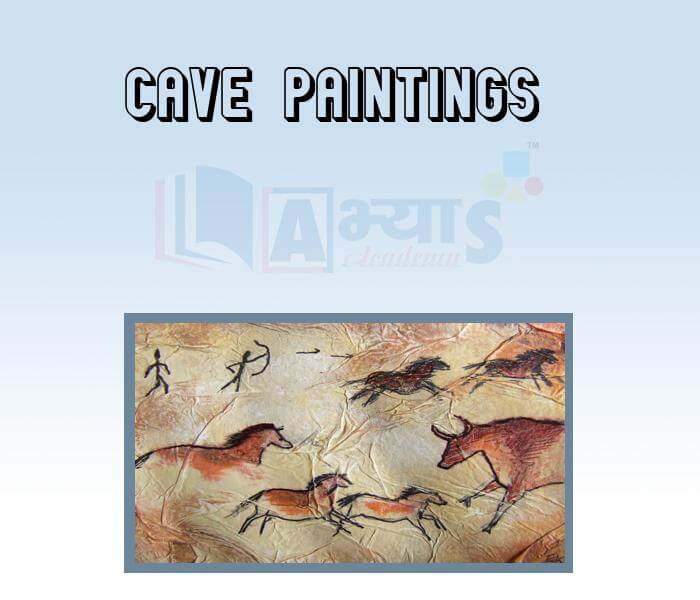Cave Paintings

Cave Painting
Ancient Caves
Haryana
Archaeologists discovered cave paintings and tools in Mangar Bani hill forest in May 2021; the cave paintings are estimated to be 10,000 years old. These are believed to be the largest in the Indian subcontinent and possibly the world's oldest.It is likely the largest paleolithic site in the Indian subcontinent and this is the first time cave paintings have been found in Aravalli.
According to Haryana Archaeology and Museums Department, "On the basis of this exploration, it can be said that this may be one of the biggest Palaeolithic sites in the Indian sub-continent, where stone age tools were recovered from different open-air sites as well as from rock shelters. Though tools from the Palaeolithic Age have been identified earlier in parts of the Aravallis, it is for the first time that cave paintings and rock art of a large magnitude have been found in Haryana."
Cave painting is a type of rock art that includes petroglyphs, or engravings, found on the wall or ceilings of caves. Mangarbani hill forest is a Palaeolithic site with rock art as well as cave paintings. It is believed to be the largest in the Indian subcontinent and possibly the world's oldest.
Karnataka
Cave paintings are found in Hiregudda which is near Badami.
Madhya Pradesh
The Bhimbetka rock shelters are an archaeological site in the state of Madhya Pradesh in central India that spans several prehistoric periods. It exhibits the earliest traces of human life on the Indian subcontinent and evidence of Stone Age habitation starting at the site in Acheulian times. It is located in the Raisen District southeast of Bhopal. Bhimbetka is a UNESCO world heritage site that consists of seven hills and over 750 rock shelters distributed over 10 kilometres (6.2 mi). At least some of the shelters were inhabited more than 100,000 years ago.
Some of the Bhimbetka rock shelters feature prehistoric cave paintings of which the oldest date from 10,000 years Before Present (BP) , corresponding to the Indian Mesolithic.The paintings show themes such as animals, and early evidence of dancing and hunting. The Bhimbetka site has the oldest known rock art in the Indian subcontinent, and is one of the largest prehistoric complexes.
Odisha
Odisha has the richest repository of rock art in Eastern India. The state has recorded more than a hundred rock shelters with rock paintings and engravings. Numerous geometric symbols, dots and lines are found along with animals, and human paintings and engravings dating from late Pleistocene onwards. Many of the geometric shape and patterns found in rock art of Odisha are enigmatic in nature. Painted figures have been found executed in monochrome, red and white or sometimes in combination with shades of yellow color.
The rock shelter of Gudahandi is located on the summit of the hillock and situated about 20 km from Block headquarters Koksara in Kalahandi district.The rock art shelter exhibits both monochrome and bi-chrome paintings of early historic period. It is the only reported rock art site of Kalahandi district. The rock art panel preserves the specimen of paintings which include a stylized human figure in red, deer and a variety of geometric patterns of squares and rectangles either empty or in filled with straight and diagonal lines or with dots on the borders grid patterns, wheels with spokes, apsidal patterns, oval shapes with dots executed either in monochrome of red or in polychrome of red, blue and black.
The rock painting of the Yogimatha (10th Millennium BCE) of Nuapada District of Odisha which was an older script in India. The script ‘Ga’, and ‘o’ (tha) was discovered from Yogimatha rock painting, this painting saw a person with four animals and write some alphabet. That painting created a word Like "Gaitha" (very popular Odia word at present ‘Gotha’ or ‘group’ in English). This art closely related to this alphabet. This alphabet has similarity to Dhauli and Jaugada Inscription's script of Ashok. It was the ancient form of Indian script and it is the first glimpse of possible origin of the Odia language and script.
Which of the following are correct : (a) Cave paintings are found in Hiregudda which is near Badami in Karnataka. (b) The Bhimbetka rock shelters are an archaeological site in the state of Madhya Pradesh. | |||
| Right Option : C | |||
| View Explanation | |||
Which of the following are correct : (a) The Bhimbetka rock shelters are located in the Raisen District southeast of Bhopal, Madhya Pradesh. (b) Bhimbetka is a UNESCO world heritage site that consists of seven hills and over 750 rock shelters distributed over 10 kilometres. | |||
| Right Option : C | |||
| View Explanation | |||
In which of the following Regions cave painting are found in India ? | |||
| Right Option : D | |||
| View Explanation | |||
Students / Parents Reviews [20]
One of the best institutes to develope a child interest in studies.Provides SST and English knowledge also unlike other institutes. Teachers are co operative and friendly online tests andPPT develope practical knowledge also.

Aman Kumar Shrivastava
10thAbhyas is an institute of high repute. Yogansh has taken admission last year. It creates abilities in child to prepare for competitive exams. Students are motivated by living prizes on basis of performance in Abhyas exams. He is satisfied with institute.

Yogansh Nyasi
7thAbout Abhyas metholodology the teachers are very nice and hardworking toward students.The Centre Head Mrs Anu Sethi is also a brilliant teacher.Abhyas has taught me how to overcome problems and has always taken my doubts and suppoeted me.

Shreya Shrivastava
8thAbhyas is a complete education Institute. Here extreme care is taken by teacher with the help of regular exam. Extra classes also conducted by the institute, if the student is weak.

Om Umang
10thIt has a great methodology. Students here can get analysis to their test quickly.We can learn easily through PPTs and the testing methods are good. We know that where we have to practice

Barkha Arora
10thMy experience with Abhyas academy is very good. I did not think that my every subject coming here will be so strong. The main thing is that the online tests had made me learn here more things.

Hiya Gupta
8thMy experience with Abhyas is very good. I have learnt many things here like vedic maths and reasoning also. Teachers here first take our doubts and then there are assignments to verify our weak points.

Shivam Rana
7thBeing a parent, I saw my daughter improvement in her studies by seeing a good result in all day to day compititive exam TMO, NSO, IEO etc and as well as studies. I have got a fruitful result from my daughter.

Prisha Gupta
8thWe started with lot of hope that Abhyas will help in better understnding of complex topics of highers classes. we are not disappointed with the progress our child has made after attending Abhyas. Though need to mention that we expected a lot more. On a scale of 1-10, we would give may be 7.

Manya
8thI have spent a wonderful time in Abhyas academy. It has made my reasoning more apt, English more stronger and Maths an interesting subject for me. It has given me a habbit of self studying

Yatharthi Sharma
10thAbhyas institute is one of the best coaching institute in the vicinity of Ambala cantt.The institute provides good and quality education to the students.The teachers are well experienced and are very helpful in solving the problems. The major advantages of the institute is extra classes for weak...

Shreya Shrivastava
8thThe experience was nice. I studied here for three years and saw a tremendous change in myself. I started liking subjects like English and SST which earlier I ran from. Extra knowledge gave me confidence to overcome competitive exams. One of the best institutes for secondary education.

Aman Kumar Shrivastava
10thIt was good as the experience because as we had come here we had been improved in a such envirnment created here.Extra is taught which is beneficial for future.

Eshan Arora
8thMy experience was very good with Abhyas academy. I am studying here from 6th class and I am satisfied by its results in my life. I improved a lot here ahead of school syllabus.

Ayan Ghosh
8thUsually we see institutes offering objective based learning which usually causes a lag behind in subjective examinations which is the pattern followed by schools. I think it is really a work of planning to make us students grab the advantages of modes of examination, Objective Subjective and Onli...

Anika Saxena
8thIn terms of methodology I want to say that institute provides expert guidence and results oriented monitering supplements by requsite study material along with regular tests which help the students to improve their education skills.The techniques of providing education helps the students to asses...

Aman Kumar Shrivastava
10thMy experience with Abhyas Academy has been very good. When I was not in Abhyas whenever teacher ask questions I could not speak it confidently but when I came in Abhyas, my speaking skills developed and now I am the first one to give the answer of teachers question.

Upmanyu Sharma
7thMy experience with Abhyas academy is very nice or it can be said wonderful. I have been studying here from seven class. I have been completing my journey of three years. I am tinking that I should join Abhyas Academy in tenth class as I am seeing much improvement in Maths and English

Hridey Preet
9thIt was a good experience with Abhyas Academy. I even faced problems in starting but slowly and steadily overcomed. Especially reasoning classes helped me a lot.

Cheshta
10thAbhyas is good institution and a innovative institute also. It is a good platform of beginners.Due to Abhyas,he has got knoweledge about reasoning and confidence.My son has improved his vocabulary because of Abhyas.Teacher have very friendly atmosphere also.








